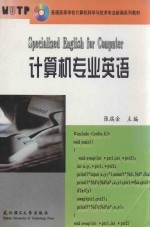图书介绍
计算机专业英语PDF|Epub|txt|kindle电子书版本下载

- 张端金主编;张端金,高曙,杨苹等编者 著
- 出版社: 武汉:武汉理工大学出版社
- ISBN:7562919275
- 出版时间:2003
- 标注页数:372页
- 文件大小:44MB
- 文件页数:386页
- 主题词:
PDF下载
下载说明
计算机专业英语PDF格式电子书版下载
下载的文件为RAR压缩包。需要使用解压软件进行解压得到PDF格式图书。建议使用BT下载工具Free Download Manager进行下载,简称FDM(免费,没有广告,支持多平台)。本站资源全部打包为BT种子。所以需要使用专业的BT下载软件进行下载。如BitComet qBittorrent uTorrent等BT下载工具。迅雷目前由于本站不是热门资源。不推荐使用!后期资源热门了。安装了迅雷也可以迅雷进行下载!
(文件页数 要大于 标注页数,上中下等多册电子书除外)
注意:本站所有压缩包均有解压码: 点击下载压缩包解压工具
图书目录
1 Introduction to Computer Science and Technology1
1.1 Introduction to the Computer Science and Technology Discipline1
1.2 Computer Science and Technology as a Discipline in China4
1.3 Related Courses7
1.4 Prospects of Computer Science and Technology9
2 Fundamentals of Computer Hardware11
2.1 Organization of Computer System11
2.1.1 System Buses11
2.1.2 CPU Organizations13
2.1.3 Memory Subsystem Organizations14
2.1.4 I/O Subsystem Organizations16
2.2 History of Computer18
2.3 Computer Interface21
2.3.1 The Internal Interfacing21
2.3.2 The External Interfacing22
2.3.3 DMA23
3 Operating System26
3.1 Introduction26
3.1.1 What is an Operating System27
3.1.2 The Evolution of Operating Systems31
3.2 The Disk Operating System33
3.2.1 Parts of DOS33
3.2.2 Starting a Computer35
3.2.3 DOS Command Format36
3.2.4 Simple DOS Commands37
3.2.5 Disk Formatting38
3.2.6 Dealing with Files40
3.3 Windows 200044
3.3.1 History44
3.3.2 Design Principles46
3.3.3 System Components48
3.4 UNIX Operating System59
3.4.1 History of the UNIX Operating System60
3.4.2 The uniqueness of UNIX60
3.4.3 How UNIX is Organized62
3.4.4 About UNIX Commands64
4 Programming71
4.1 Introduction to Programming71
4.1.1 What Is Programming71
4.1.2 How Do We Writer a Program72
4.1.3 Programming Paradigms76
4.2 Programming Languages80
4.2.1 Early Generation80
4.2.2 Selecting a Programming Language84
4.3 Object-Oriented Programming89
4.3.1 Objects91
4.3.2 Classes92
4.3.3 Inheritance93
4.3.4 Some Real Life Examples95
5 Design and Analysis of Algorithms99
5.1 The Role of Algorithms in Computing99
5.1.1 Algorithms99
5.1.2 Algorithms as a Technology104
5.2 Analyzing Algorithms109
5.2.1 Analysis of Insertion Sort111
5.2.2 Worst-Case and Average-Case Analysis114
5.2.3 Order of Growth115
5.2.4 Growth of Functions115
5.3 Designing Algorithms123
5.3.1 The Divide-and-Conquer Approach123
5.3.2 Analyzing Divide-and-Conquer Algorithms127
6 Parallel Processing132
6.1 Introduction132
6.1.1 Computational Demands of Contemporary Science133
6.1.2 Advent of Practieal Parallel Processing135
6.1.3 Some Basic Parallel Algorithms136
6.2 Parallel Algorithm Design142
6.2.1 Partitioning144
6.2.2 Communication144
6.2.3 Agglomeration146
6.2.4 Mapping146
6.3 Applications of Parallel Processing-Mandelbrot Set150
7 Data Mining and Applications162
7.1 Basic Concepts162
7.1.1 Date Mining162
7.1.2 Database,Data Warehouse and Data Mart165
7.2 Data Mining Process171
7.2.1 How Data Mining Works171
7.2.2 Date Mining Process174
7.2.3 Date Mining Terminology177
7.3 Data Mining Model178
7.3.1 Decision Trees178
7.3.2 Genetic Algorithms179
7.3.3 Neural Nets180
7.3.4 Agent Network Technology180
7.3.5 Hybrid Models181
7.3.6 Statistics181
7.4 Data Mining Applications183
7.4.1 Data Mining Application Field183
7.4.2 Data Mining Case Studies185
7.4.3 Data Mining Application Through Data Warehouses186
8 Image Processing and Machine Vision191
8.1 Introduction191
8.1.1 Image Technology191
8.1.2 Digital Image Definitions194
8.2 Image Processing Algorithm198
8.2.1 Tools198
8.2.2 Mathematics-based Operations201
8.2.3 Convolution-based Operations203
8.2.4 Smoothing Operations204
8.3 Compression or Decompression Techniques208
8.3.1 Two Basic Types of Compression208
8.3.2 Image Compression/Decompression Development210
8.4 Object Recognition214
8.4.1 Description214
8.4.2 Key Features for Object Recognition215
8.5 3D Vision and Applications217
8.5.1 Basic Concept217
8.5.2 Applications217
9 Computer Networks and Communications220
9.1 Data Communications220
9.1.1 Fundamentals of Data and Signals221
9.1.2 The Media of Transmission222
9.1.3 Multiplexing225
9.1.4 Making Connections230
9.2 Computer Networks233
9.2.1 Understand Networking Concepts233
9.2.2 Local Area Networks234
9.2.3 Wide Area Networks237
9.2.4 The Internet239
9.3 Broadband Integrated Services Digital Network(BISDN)243
9.3.1 Introduction243
9.3.2 A Brief History243
9.3.3 Broadband ISDN Services244
9.4 Asvnchronous Transfer Mode(ATM)246
9.4.1 Basic Concepts in ATM247
9.4.2 ATM Standards248
9.4.3 ATM Switching249
9.4.4 ATM Networks251
9.4.5 ATM Applications254
10 Information and Network Security257
10.1 Security Problem in Computer System257
10.1.1 Introduction257
10.1.2 Different Types Of Network Security258
10.2 Some Approaches to Defense260
10.2.1 Basic Security Measures260
10.2.2 Standard System Attacks268
10.2.3 Basic Encryption and Decryption Techniques270
10.2.4 Public Key Infrastructure278
10.2.5 Firewalls281
10.2.6 Security Policy Design Issues285
11 Electronic Commerce289
11.1 Introduction289
11.1.1 What Is E-Commerce290
11.1.2 The Role of Strategy in E-Commerce295
11.2 Value Chains in E-Commerce297
11.2.1 Value Chains in E-Commerce297
11.2.2 Integrating E-Commerce299
11.3 Applications of Electronic Commerce305
11.3.1 Applications of Electronic Commerce305
11.3.2 Unique Benefits of E-Commerce307
11.4 Advantages and Limitations of E-Commerce314
11.4.1 Advantages315
11.4.2 Limitations318
12 Internet Congestion Control321
12.1 Introduction321
12.1.1 The Problem of Congestion323
12.1.2 The Threat of Congestion Collapse324
12.1.3 TCP Friendliness324
12.2 Classification of Congestion Control Schemes326
12.2.1 Window-Based vs.Rate-Based327
12.2.2 Unicast vs.Multicast327
12.2.3 Single-Rate vs.Multirate328
12.2.4 End to End vs.Router-Supported329
12.3 Congestion Control Mechanisms331
12.3.1 End-to-End Flow Control335
12.3.2 Feedback Mechanisms335
12.3.3 Implicit Feedback335
12.3.4 Explicit Feedback335
12.3.5 Scheduling Mechanisms336
12.3.6 Buffer and Queue Management Mechanisms338
12.3.7 Buffer Management339
12.3.8 Queue Management339
12.3.9 Queue Management for Congestion Recovery340
12.3.10 Active Queue Management for Congestion Avoidance341
12.4 Recent Developments in Congestion Control345
12.4.1 Avoiding Unnecessary Retransmit Timeouts345
12.4.2 Undoing Unnecessary Congestion Control Responses to Reordered or Delayed Packets346
13 International Academic Exchanges349
13.1 Call for Papers350
13.2 The Academic Paper355
13.2.1 Introduction356
13.2.2 Problem Formulation357
13.2.3 Main Results359
13.2.4 Conclusion363
13.3 Participation in the Conference365
13.3.1 To Chair a Conference365
13.3.2 To Present a Paper368
13.3.3 To Ask and Answer Questions369
Appendix Glossaries in Computer Science373
References404